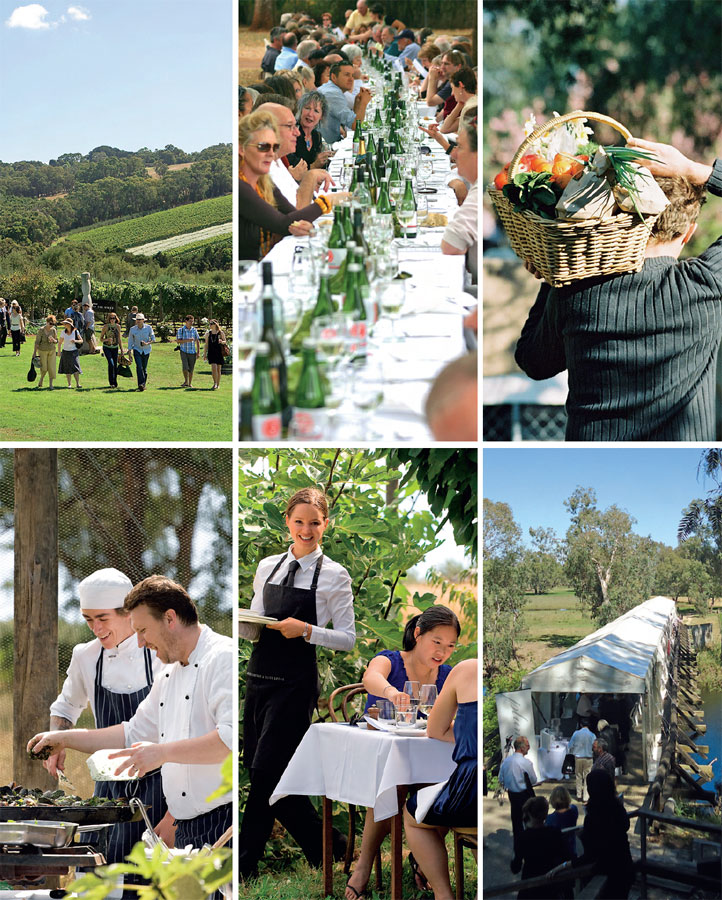Beyond Melbourne
One of the major reasons for the strength and depth of Melbourne’s food and wine culture is that the city is surrounded on all sides by regional areas that produce an amazing array of brilliant things to drink and eat. It has been one of the Melbourne Food and Wine Festival’s major achievements that it has helped alert Melburnians to the fact of the many delicious drinkable and edible riches right on their doorstep through a constantly expanding regional program.
In the Festival’s early days, however, most of the energy was centred on Melbourne, which had more to do with limited resources than lack of interest. But it was also the case that Victoria’s regions in the early 1990s did not have the distinct identities they have now. There was no coherent plan to promote regional wine and food tourism and city slickers were mostly unaware of what the countryside had to offer in terms of food and wine. In some cases the lack of greater awareness of all the good stuff in Victoria was partly due to the producers themselves who, having little to compare themselves with or opportunity to see what others were doing, were not aware of how good, even special, the food they were growing was. The Festival helped to promote events in regional Victoria, bringing the regions into the city by way of showcases, workshops, markets and dinners.
Aside from the Winemaker Dinners in the first couple of Festivals, the initial regional events consisted of balloon-ride-over-the-vineyard or drink-some-wine-and-listen-to-some-jazz type events. But then in 1998, the first of the Regional Producers Showcases and the Regional Food and Wine Tourism Workshops were organised which brought together small and artisan producers from across the state. Sylvia Johnson said it was remarkable to "see the small growers from all around Victoria coming together for the first time and coming to the realisation that they were not alone and, together, they had a lot to offer".
On the back of that discovery people such as Suzanne Halliday, wife of wine writer and Festival friend James, and dedicated spruiker of the Yarra Valley, championed the cause of the regions, helping to bring regionally specific produce to both the Festival and to Victoria through farmers’ markets. In this way, people in the city — and in the regional areas where these markets began sprouting both in and out of Festival time — could access both the product and producer.
Then there were people such as George Biron, who every year runs a program of themed events from his farm in Deans Marsh, covering everything from wild food to the legacy of Elizabeth David. Or Alla Wolf-Tasker, a tireless worker for the regional cause that she embodies at her renowned Daylesford restaurant (and constant Festival venue), Lake House. Or Stefano de Pieri, a long-time and enthusiastic Festival participant, who has given the agricultural richness of Mildura a permanent place on the regional-produce map.
The level of interest and the size of the crowds that regional gatherings run by these people generated gave different regions the confidence to hold their own events during the Festival. For example, in 2005 Fruits of Our Labour shone the spotlight on the food and wine (especially pinot noir) of the Mornington Peninsula, and the Yarra Valley was the host of a series of Slow Food workshops that focused on the making of cheese, pasta, preserves and cured meat.
Of course, the event that really brought city and regions together symbolically was the World’s Longest Lunch. After the first three Lunches had proved to be so successful in Melbourne, the decision was made to extend the lunches into the country as a way of promoting tourism to the regions. Now there are 25-plus Long Lunches held throughout Victoria in botanic gardens, on the foreshore of Port Phillip Bay, on wharfs and bridges, in showgrounds and wineries and on Avenues of Honour. There are lunches in the Grampians, the Yarra Valley and Dandenong Ranges, along the Murray River, on the Mornington and Bellarine peninsulas, along the Great Ocean Road, in the Macedon ranges and up in the High Country.
Working with the many dedicated people, including Wolf-Tasker, Biron, Halliday, Patrizia Simone, de Pieri and Dur-e Dara, who push the regional cause all year round, the Festival has been able to bring the message to a greater, food-savvy section of the population. And in doing so they have forged links that make the Festival feel as if it belongs not just to the capital but to the entire state.

Adundance Dining, 2010; Regional World’s Longest Lunch, 2007; Regional Produce, 2009;World’s Longest Lunch, North East Valley, 2011; Abundance Dining, 2010 (bottom centre and left).